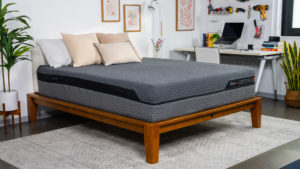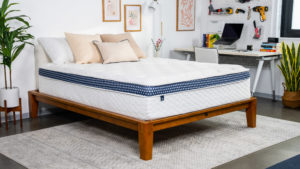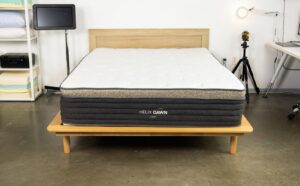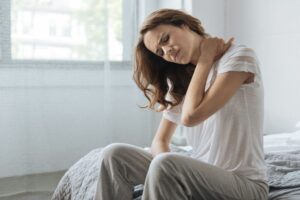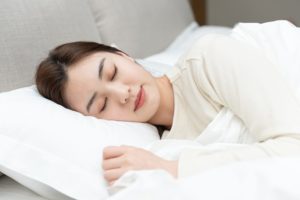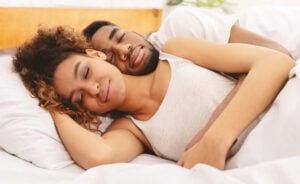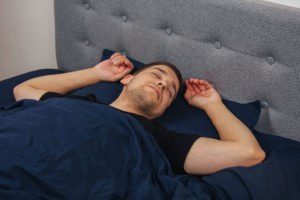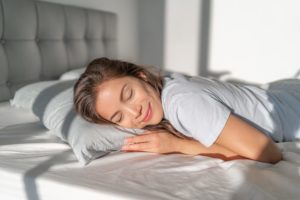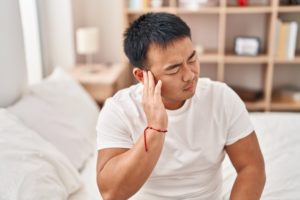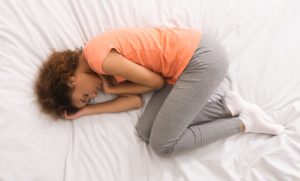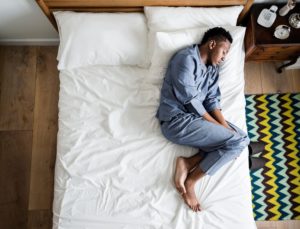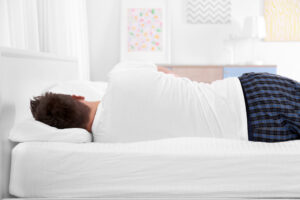When you buy through our links, we may earn a commission. Products or services may be offered by an affiliated entity. Learn more.
Best Sleeping Positions
- Side sleeping is the most common sleep position and is often the best choice for relieving back pain and reducing sleep apnea symptoms.
- Back sleeping feels natural to many people but can contribute to snoring, sleep apnea, and acid reflux.
- Stomach sleeping is the least common position. It may help prevent snoring, but can strain your neck and lower back.
You spend about a third of your life asleep, and during that time, your body works to restore and repair itself. Your sleep position can either help or hinder that process. Knowing the pros and cons of different sleeping positions enables you to find a sleep posture that maximizes support, comfort, and overall health.
Why Sleeping Position Matters
People frequently overlook the importance of their sleeping position, but your sleep posture influences how your body feels, the quality of your sleep, and even certain health conditions. For example, if you’ve ever woken up with a stiff neck or sore back and had no idea what caused it, your sleep position might be the culprit.
Finding the right sleep position can relieve stress on your spine and joints. It can also affect things like your breathing and your risk of heartburn. In other words, if you want good sleep quality and want to wake up feeling your best, the evidence is clear that your sleeping position matters.
Is Your Troubled Sleep a Health Risk?
A variety of issues can cause problems sleeping. Answer three questions to understand if it’s a concern you should worry about.
The Best Sleeping Position for You
The best sleep position is one that promotes healthy spinal alignment from your hips all the way to your head. What that looks like for you depends on your health situation and what you find comfortable.
Having said that, there are some positions that are considered healthier than others. Specifically, sleeping on the side or back is considered more beneficial than sleeping on the stomach. In either of these positions, it’s easier to keep your spine supported and balanced, which relieves pressure and enables your muscles to relax and recover.
However, spinal support is just one part of the equation. Your sleeping position can also have effects on a range of health issues, including sleep apnea, acid reflux, and pain.
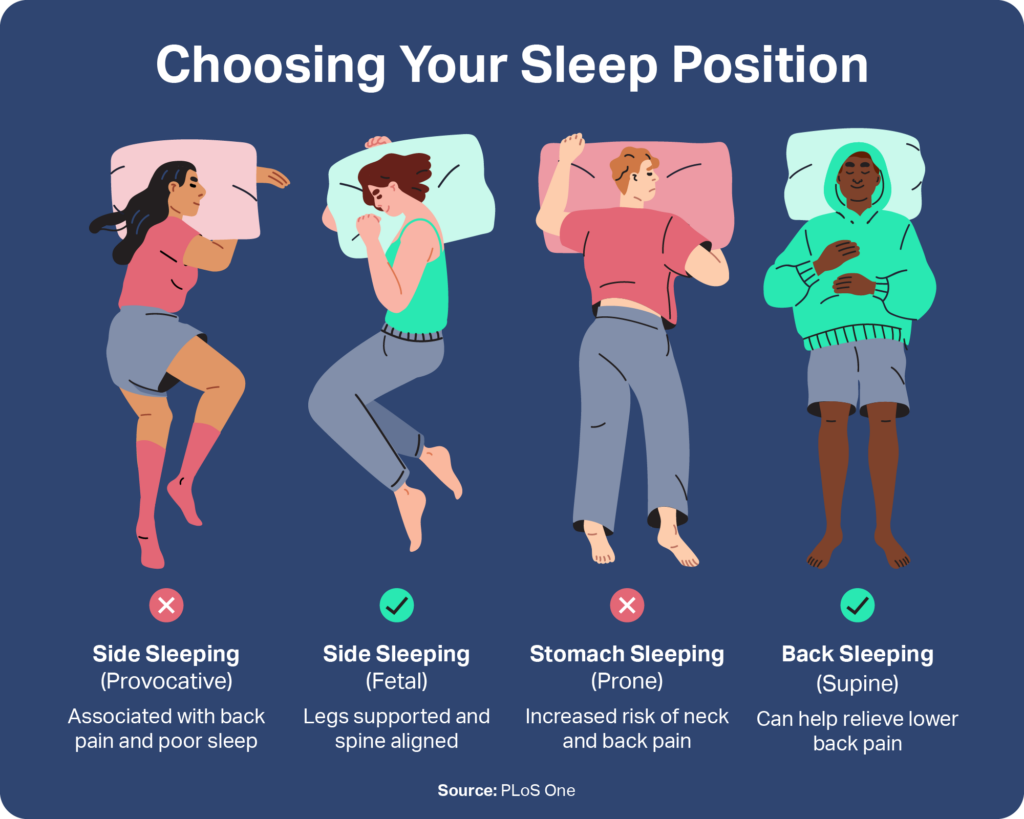
Best Sleeping Position for Sleep Apnea
Sleeping on your side or stomach is typically best for sleep apnea . In contrast, sleeping on your back is the worst for obstructive sleep apnea (OSA). When you lie on your back, gravity can pull your tongue and soft tissues around your throat into a position that blocks your breathing.
For some people, back sleeping is a major factor behind disrupted breathing. This is known as positional obstructive sleep apnea, and some studies estimate that it affects around half of people with OSA. In fact, some people only have symptoms when they sleep on their back.
Because of this, switching to a side or stomach sleeping position can reduce symptoms for many people with OSA. Some people even use special devices designed to discourage back sleeping at night.
There’s also some evidence that raising the head of the bed can reduce breathing interruptions. This may be a useful step for those who find it difficult or impossible to avoid sleeping on their back.
If you use a CPAP or another positive airway pressure (PAP) device to treat sleep apnea, your sleeping position can influence how you choose a mask.
For people with central sleep apnea (CSA), a less common type of sleep apnea, side sleeping is usually the best position, but this is not as beneficial for OSA.
Best Sleeping Position for Heartburn and GERD
If you deal with heartburn or gastroesophageal reflux disease (GERD), sleeping on your left side is usually the best position. This position helps make it harder for stomach acid to reach the junction between the stomach and esophagus.
Conversely, sleeping on your right side or flat on your back can make GERD symptoms worse, as these positions make it easier for stomach acid to flow up into the esophagus.
Another way to get relief is to elevate the head of your bed by about six inches. This incline allows gravity to help keep stomach contents down while you sleep. Sleeping on your left side with the head of the bed raised offers the biggest benefit.
Best Sleeping Position for Back Pain
The best sleeping position for lower back pain is on your side with your knees slightly bent. Putting a small pillow between your knees may take additional strain off of your lower back. Choose a pillow with a loft, or thickness, that matches the distance between your neck and your shoulder. This allows your entire spine to stay in a neutral position, and that spinal alignment helps reduce neck and back pain.
Best Sleeping Position for Neck Pain
For many people, back sleeping is the best sleep position for neck pain because it reduces overactivity of the muscles around your neck. When lying on your back, try to keep your arms in similar positions so that you don’t put more pressure on one side of your body. Use a relatively low-loft pillow or a pillow with a divot that holds your neck in a neutral position.
Sleeping on your side can also help limit neck pain, as long as you have a supportive pillow. In any position, try to make sure your pillow cradles your neck without an exaggerated angle tilting up or down.
Best Sleeping Position for Hip or Knee Pain
Both hip and knee pain can have many causes, and the ideal sleep position can depend on the underlying problem. That said, experts often suggest sleeping on your side with a pillow between your knees to reduce hip pain and knee pain . Some people find that this position keeps the hips, pelvis, and spine aligned, easing pressure on joints and muscles.
Be careful, though, because sleeping on your side can put more pressure on your hip. If you have hip pain on only one side, try sleeping on the other side.
If you have knee pain and prefer to sleep on your back, placing a pillow under your knees may be helpful. It can reduce pressure from the mattress that pushes your knee into a fully extended or locked position.
Best Sleeping Position for Pregnancy
Experts recommend that those who are pregnant sleep on their left side with the knees bent . This posture improves circulation, making it easier for nutrient-rich blood to reach the placenta, and can help reduce pressure on the liver and lower back. It may also help ease swelling in the legs, feet, and hands.
If you experience discomfort sleeping on your left side during pregnancy, you can switch to your right side now and then to relieve pressure on your left hip. You can also reduce tension by placing pillows under the belly, between the legs, and at the small of the back.
Best Sleeping Position for Stuffy Nose
If you’re coping with allergies or a stuffy nose, use pillows to prop up your upper back so you’re in a more upright position. This positioning helps your airways stay open and may help drain your nose. Avoid lying flat on your back, as that may increase nasal congestion .
Best Sleeping Position for Avoiding Wrinkles
Conventional wisdom holds that back sleeping is the best position to help prevent wrinkles. When you lie on your back, your face doesn’t press against the pillow. This reduces the risk of your face’s skin creasing and compressing, which may lead to wrinkles over time.
However, there are limited studies on sleep wrinkles. Some research has found few differences in the faces of people who sleep on their side. Many other factors affect the development of wrinkles, including things unrelated to your sleep position, such as sun exposure and genetics.
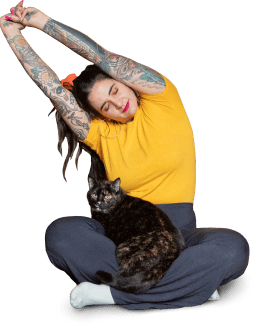
Sleeping on Your Side
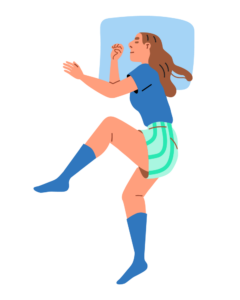
As children, we split our nights by sleeping in multiple positions, but by adulthood, a clear preference for side sleeping emerges. In fact, it’s estimated that more than 60% of adults sleep on their side. The flexibility of our spine decreases as we age, which may make the side sleeping position more comfortable for older adults.
When side sleeping, you want to try to keep your spine in a straight, neutral line from your neck to your hips. Use a pillow that fills the space between your head and the mattress so your neck isn’t bent too far up or down.
Try to keep your body on an even vertical plane so that you’re not twisting, which can strain your shoulders and back. Many side sleepers like to put a thin pillow between their knees, which helps hold the hips in a more aligned position. It can also reduce pressure in the lower back.
Try out these strategies and, if needed, make small modifications to find a position that feels comfortable and enables you to wake up without aches and pains.
Drawbacks to Sleeping on Your Side
Side sleeping may not be right for people with shoulder pain or those who are worried about facial wrinkles.
Side sleeping can lead to soreness or tightness in your shoulders , so it’s good to shift positions occasionally and use the most appropriate pillow and mattress. Ensure your mattress has enough “give” to properly cushion your hips and shoulders so that there isn’t excess impact or pressure.
Some evidence suggests that side sleeping can contribute to facial wrinkles , since your face is pressed against the pillow, stretching and compressing the skin. However, not all research has found side sleeping to be associated with wrinkles.
Sleeping on Your Left Side vs. Right Side
If you’re already a side sleeper and want to go for that gold star, opt to sleep on your left instead of your right side. Because of how it positions your internal organs, experts recommend the left side for people with acid reflux or gastroesophageal reflux disease (GERD). Sleeping on the left side is also suggested for pregnant people.
Sleeping on Your Back
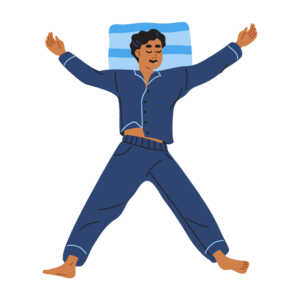
Lying on the back is the second most popular sleep position. When you’re flat on your back, it’s often easier to keep your spine in alignment and to evenly distribute your body’s weight, preventing aches in the neck, shoulders, or lower back.
When lying on your back, you want to maximize support for your lower back. For some people, it helps to put a thin pillow under the small of the back or under the knees. The goal is to reduce stress in the lumbar area.
Use a pillow that supports the natural curve of your neck without being excessively high. Your shoulders should lie flat, and you can rest your arms at your sides or on your torso. Try to keep your arms in the same position to reduce asymmetrical strain on your neck muscles.
While there are some concerns that can arise from back sleeping, elevating the head of your bed may help alleviate them. For example, raising your upper body may reduce snoring, acid reflux, and congestion from a stuffy nose or allergies.
Drawbacks to Sleeping on Your Back
The back sleeping position is not recommended for:
- Pregnant people
- People who snore or have sleep apnea
- People with some types of back pain
- People with GERD or acid reflux
- Heavier adults
- Older adults
Back sleeping is the worst sleeping position for people with snoring and sleep apnea, as it leaves you susceptible to airway collapse. For most people with obstructive sleep apnea, the severity of symptoms increases when back sleeping. Especially as we grow older or heavier, it becomes harder to breathe while lying on our backs due to the pressure of gravity on the body.
Also, while some people feel comfortable and aligned in a back sleeping position, others find that it increases back pain. Depending on the firmness of your mattress, a small gap can form between your lower back and the mattress surface, leading to tension in the lower back. You can resolve this by placing a thin pillow in that area or by placing a pillow under your knees. Either way, you’ll relieve pressure while supporting the natural curvature of your spine. You can also switch between back and side sleeping throughout the night.
The back sleeping position is not recommended for pregnant people, because the weight of a growing baby on veins and blood vessels can limit blood flow through the body. Studies are inconclusive about whether back sleeping during the third trimester poses any risk to a fetus. Some have argued that it can increase the risk of stillbirth, but other research has found no effect.
Sleeping on Your Stomach
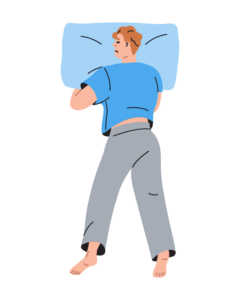
Lying face-down is the least popular sleep position. Research suggests we spend less than 10% of our night sleeping in this position. Stomach sleeping does have a few potential benefits, however. Namely, it can avoid some issues related to back sleeping, such as a greater risk of snoring.
Drawbacks of Sleeping on Your Stomach
The stomach sleeping position comes with several drawbacks and is not recommended for most people. In particular, the following people should avoid sleeping on their stomachs:
- Pregnant people
- People with neck or back pain
- People worried about wrinkles
The stomach position provides the least back support of all sleeping positions and increases pressure on the spine, sometimes causing pain upon waking up. In order to sleep on your stomach, you usually turn your head to one side, invariably twisting your neck and head out of alignment with the rest of your spine.
If your mattress isn’t firm enough, your stomach and hips will sink into the mattress, uncomfortably pulling your spine into a U-shape. This kind of asymmetrical sleep posture can negatively impact your spine over time. Also, sleeping on your stomach may contribute to facial wrinkles since your face is pressed against the pillow or the surface of the mattress.
How to Sleep Better on Your Stomach
Without the right pillow and mattress, it’s easy for the stomach sleeping position to cause aches and pains. However, it is possible to sleep well in this position. If you enjoy sleeping on your stomach, try using a very thin pillow or no pillow at all. This way, you can avoid tilting your neck back and up, which creates further spinal misalignment and discomfort.
You can also try placing a thin pillow under your hips to further even out the spine and relieve pressure. In addition, having a firm mattress can prevent some of the spinal alignment issues that come from sleeping on your stomach.
Other Sleeping Positions
Side sleepers, back sleepers, and stomach sleepers account for the majority of the population, but they don’t represent everyone. Many people swap positions multiple times throughout the night. We call these combination sleepers or hybrid sleepers.
Other positions that might resonate with you include variations on the three detailed above.
- Fetal position: This is a more curled-up version of side sleeping. It’s named after the way babies grow in the womb.
- Freefall: This is a variant of stomach sleeping with your hands wrapped around or under your pillow and your head turned to the side.
- Yearner: In this version of side sleeping, your arms and legs are stretched out in front of you, like you’re reaching for something. You may have noticed your dog likes to sleep this way.
- Soldier: This is a type of back sleeping but with your arms held straight against your sides, as if you’re standing at attention (horizontally, of course).
- Starfish: In the starfish style of back sleeping, your limbs are extended in every direction as far as they go.
- Log: This type of side sleeping involves no bending at the waist, knees, or elbows.
- Cliffhanger: This is when couples sleep on opposite sides of the bed, right up against the edges, with their backs toward each other.
Changing Your Sleep Position
Should you change your sleep position? Each sleep position has benefits and drawbacks. If you’re starting to think that a different one might be better for your comfort or health, you might be wondering whether it’s actually worth trying to make a change.
Unfortunately, there’s no one-size-fits-all answer. There can be benefits to adopting a new sleeping position. For some conditions, like obstructive sleep apnea, changing your sleep position can make a real difference. In one small study of older adults with back pain, people who adjusted their position for better back support saw noticeable pain relief in just four weeks.
However, it’s not easy to switch away from your natural sleeping position. Even if you fall asleep in a new position, you may revert back to your old position during the night. And if the new position makes it harder to get comfortable, it could end up being harder to get a good night’s sleep.
If you do want to try a new sleep position, just know it may take some time to adjust. You might want to consider extra pillows to help position your body or products designed to facilitate a specific sleep posture. No matter what position you ultimately go with, make sure you have the best mattress and pillow for optimal support.
In the end, the best sleep position for you is whichever one enables you to enjoy restful sleep and to wake up in the morning feeling refreshed and free of aches and pains. If that describes your current sleep position, don’t feel forced to change it. If you think a new position might make sleep more comfortable for you, though, go ahead and give it a try.

Still have questions? Ask our community!
Join our Sleep Care Community — a trusted hub of sleep health professionals, product specialists, and people just like you. Whether you need expert sleep advice for your insomnia or you’re searching for the perfect mattress, we’ve got you covered. Get personalized guidance from the experts who know sleep best.
References
28 Sources
-
Cary, D., Briffa, K., & McKenna, L. (2019). Identifying relationships between sleep posture and non-specific spinal symptoms in adults: A scoping review. BMJ Open, 9(6), e027633.
https://pubmed.ncbi.nlm.nih.gov/31256029/ -
Rinaldi, V., Costantino, A., Luchena, A., & Casale, M. (2022, March 2). Sleep-disordered breathing and CPAP treatment and management. Medscape.
https://emedicine.medscape.com/article/870192-treatment#showall -
Gao, Y., Zhu, S., Li, W., & Lai, Y. (2025). Comparative efficacy of sleep positional therapy, oral appliance therapy, and CPAP in obstructive sleep apnea: a meta-analysis of mean changes in key outcomes. Frontiers in medicine, 12, 1517274.
https://doi.org/10.3389/fmed.2025.1517274 -
A.D.A.M. Medical Encyclopedia. (2023, January 9). Obstructive sleep apnea – adults. MedlinePlus.
https://medlineplus.gov/ency/article/000811.htm -
Ravesloot, M. J., van Maanen, J. P., Dun, L., & de Vries, N. (2013). The undervalued potential of positional therapy in position-dependent snoring and obstructive sleep apnea: A review of the literature. Sleep and Breathing, 17(1), 39–49.
https://pubmed.ncbi.nlm.nih.gov/22441662/ -
Chang, J. L., Goldberg, A. N., Alt, J. A., Mohammed, A., Ashbrook, L., Auckley, D., Ayappa, I., Bakhtiar, H., Barrera, J. E., Bartley, B. L., Billings, M. E., Boon, M. S., Bosschieter, P., Braverman, I., Brodie, K., Cabrera-Muffly, C., Caesar, R., Cahali, M. B., Cai, Y., Cao, M., … Rosen, I. M. (2023). International Consensus Statement on Obstructive Sleep Apnea. International forum of allergy & rhinology, 13(7), 1061–1482.
https://doi.org/10.1002/alr.23079 -
Lukachan, G. A., Yadollahi, A., Auckley, D., Gavrilovic, B., Matelski, J., Chung, F., & Singh, M. (2023). The impact of semi-upright position on severity of sleep disordered breathing in patients with obstructive sleep apnea: a two-arm, prospective, randomized controlled trial. BMC anesthesiology, 23(1), 236.
https://doi.org/10.1186/s12871-023-02193-y -
Pinna, G. D., Robbi, E., La Rovere, M. T., Taurino, A. E., Bruschi, C., Guazzotti, G., & Maestri, R. (2015). Differential impact of body position on the severity of disordered breathing in heart failure patients with obstructive vs. central sleep apnoea. European Journal of Heart Failure, 17(12), 1302–1309.
https://pubmed.ncbi.nlm.nih.gov/26467056/ -
Gurges, P., Murray, B. J., & Boulos, M. I. (2022). Relationship between gastroesophageal reflux disease and objective sleep quality. Journal of clinical sleep medicine : JCSM : official publication of the American Academy of Sleep Medicine, 18(12), 2731–2738.
https://doi.org/10.5664/jcsm.10198 -
Simadibrata, D. M., Lesmana, E., Amangku, B. R., Wardoyo, M. P., & Simadibrata, M. (2023). Left lateral decubitus sleeping position is associated with improved gastroesophageal reflux disease symptoms: A systematic review and meta-analysis. World journal of clinical cases, 11(30), 7329–7336.
https://doi.org/10.12998/wjcc.v11.i30.7329 -
Lynch, K. L. (2022, March). Gastroesophageal reflux disease (GERD). Merck Manual Consumer Version.
https://www.merckmanuals.com/home/digestive-disorders/esophageal-and-swallowing-disorders/gastroesophageal-reflux-disease-gerd -
Ylinen, J., Häkkinen, A., Kautiainen, H., & Multanen, J. (2024). Preferences and Avoidance of Sleeping Positions Among Patients With Chronic Low Back Pain: A Cross-Sectional Study. Cureus, 16(5), e59772.
https://doi.org/10.7759/cureus.59772 -
Lee, W. H., & Ko, M. S. (2017). Effect of sleep posture on neck muscle activity. Journal of Physical Therapy Science, 29(6), 1021–1024.
https://pubmed.ncbi.nlm.nih.gov/28626314/ -
MedlinePlus: National Library of Medicine (US). (2023, April 4). Hip Pain.
https://medlineplus.gov/ency/article/003179.htm -
MedlinePlus: National Library of Medicine (US). (2024, November 4). Knee Pain.
https://medlineplus.gov/ency/article/003187.htm -
A.D.A.M. Medical Encyclopedia. (2020, June 2). Problems sleeping during pregnancy. MedlinePlus.
https://medlineplus.gov/ency/patientinstructions/000559.htm -
Berson, S. R., Klimczak, J., Prezio, E. A., Hu, S., & Abraham, M. (2018). Clinical associations between allergies and rapid eye movement sleep disturbances. International Forum of Allergy & Rhinology, 8(7), 817–824.
https://pubmed.ncbi.nlm.nih.gov/29461689/ -
Anson, G., Kane, M. A. C., & Lambros, V. (2016). Sleep wrinkles: Facial aging and facial distortion during sleep. Aesthetic Surgery Journal, 36(8), 931–940.
https://pubmed.ncbi.nlm.nih.gov/27329660/ -
Kotlus B. S. (2013). Effect of sleep position on perceived facial aging. Dermatologic surgery : official publication for American Society for Dermatologic Surgery [et al.], 39(9), 1360–1362.
https://doi.org/10.1111/dsu.12266 -
MedlinePlus: National Library of Medicine (US). (2022, November 30). Wrinkles
https://medlineplus.gov/ency/article/003252.htm -
De Koninck, J. Lorrain, D., & Gagnon, P. (1992). Sleep positions and position shifts in five age groups: An ontogenetic picture. Sleep, 15(2), 143–149.
https://pubmed.ncbi.nlm.nih.gov/1579788/ -
Zenian, J. (2010). Sleep position and shoulder pain. Medical Hypotheses, 74(4), 639–643.
https://pubmed.ncbi.nlm.nih.gov/20036076/ -
American College of Obstetricians and Gynecologists. (2021, January). Can I sleep on my back while pregnant?
https://www.acog.org/womens-health/experts-and-stories/ask-acog/can-i-sleep-on-my-back-when-im-pregnant -
Katz, J., Sanapo, L., Bublitz, M. H., Guillen, M., Avalos, A., Aldana, A., Wilson, D., & Bourjeily, G. (2024). Longitudinally assessed maternal sleep position, measures of breathing during sleep, and fetal growth in high-risk pregnancies. Sleep, 47(2), zsad315.
https://doi.org/10.1093/sleep/zsad315 -
Wilson, D. L., Fung, A. M., Pell, G., Skrzypek, H., Barnes, M., Bourjeily, G., Walker, S. P., & Howard, M. E. (2022). Polysomnographic analysis of maternal sleep position and its relationship to pregnancy complications and sleep-disordered breathing. Sleep, 45(4), zsac032.
https://doi.org/10.1093/sleep/zsac032 -
Dunietz, G. L., Sever, O., DeRowe, A., & Tauman, R. (2020). Sleep position and breathing in late pregnancy and perinatal outcomes. Journal of clinical sleep medicine : JCSM : official publication of the American Academy of Sleep Medicine, 16(6), 955–959.
https://doi.org/10.5664/jcsm.8416 -
Skarpsno, E. S., Mork, P. J., Nilsen, T. I. L., & Holtermann, A. (2017). Sleep positions and nocturnal body movements based on free-living accelerometer recordings: Association with demographics, lifestyle, and insomnia symptoms. Nature and Science of Sleep, 9, 267–275.
https://pubmed.ncbi.nlm.nih.gov/29138608/ -
Desouzart, G., Matos, R., Melo, F., & Filgueiras, E. (2015). Effects of sleeping position on back pain in physically active seniors: A controlled pilot study. Work, 53(2), 235–240.
https://pubmed.ncbi.nlm.nih.gov/26835867/


